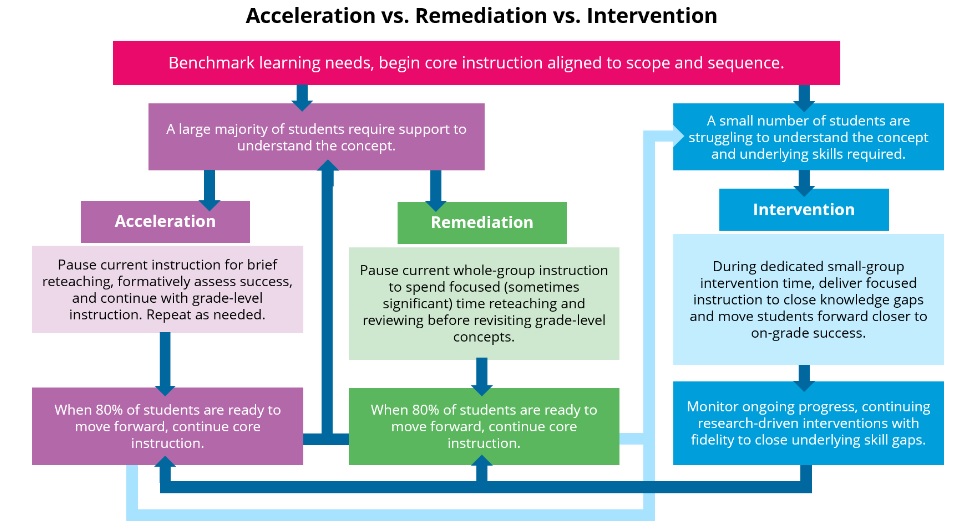
What Is The Best Approach For Student Success? Intervention Vs Remediation Vs Acceleration
The ultimate objective of intervention, remediation, and acceleration is to help underachieving pupils succeed academically. However, if you dig a little further, you'll discover that the distinctions between these three types of approaches are crucial for figuring out what kind of setting, timing, and strategy would be needed for effectively supporting struggling students. To clarify the distinctions between these phrases and offer suggestions for when and when to include them in your teaching day, let's examine them in more detail.
What Is The Student Intervention Method?
One of the most common ways that teachers provide official help for difficult students is through student intervention. When 15% of students or fewer have difficulty with a particular idea or ability, an intervention is beneficial. It provides regular evaluation and tracking while concentrating on a specific learning objective.

Intervention can be defined as either a multi-tiered system of support (MTSS) or as a reaction to intervention (RTI).
- Multi-Tiered System Of Support (MTSS)
The goal of a multi-tiered support system is to put interventions into action. It highlights the importance of teachers and other caring persons in the learning environment. Differentiation is another tool used by MTSS to boost the effectiveness of training in a supportive setting. - Response To Intervention (RTI)
Response to intervention is a three-phase process that begins with a solid base of excellent, scientifically validated training. After that, more help is provided to each group as needed when they react to this instruction. Students who appear to be having difficulty with the content are given more challenging training in the second phase.
Do you follow us on Social Media? We regularly share upgraded educational content, tips, feedback, and more. Check us out by clicking the profiles here - Facebook / Twitter / LinkedIn / Pinterest / Instagram / YouTube
When To Use Intervention In Your Classroom?
It's likely that you now employ intervention in your classroom. You employ intervention each time you provide additional help to a student or group of pupils who are having difficulty. When you observe that specific pupils are lagging in certain ideas and abilities, you should utilize intervention. Your intervention should focus on these ideas and abilities without deviating from the established learning objectives.
What Is The Remediation Approach?
Remediation is the process of teaching topics and abilities that students find difficult in the classroom again. To meet the learning objectives of lower grade levels, the instructor must drill prior information. In situations when 80% or more of the pupils are failing to meet the grade-level learning objectives, teachers often provide remediation to the whole class. One crucial aspect of Remediation is formative assessments.
- Formative Assessments
Formative assessment helps teachers determine how, when, and how much remediation a student needs for a particular topic or ability, and hence it is an essential component of remediation. A teacher may provide more timely and focused remedial help if they regularly examine the ideas and abilities that the students are missing in the class.
When To Use Remediation?
When the majority of the class has difficulty understanding a concept or skill that is directly relevant to your present learning objective, you should utilize remediation. Once 80% or more of the class demonstrates knowledge and mastery, the teacher should pause the lesson, go over what the pupils missed the first time, and then continue.
What Is The Acceleration Approach?
Acceleration is the process of stopping group instruction to quickly re-teach the previously taught foundational concepts or skills. Before going on to the current grade-level learning objectives, the instructor does a quick assessment to see if the children have understood what has been reiterated. Since acceleration is an iterative method, the instructor will probably stop the lesson and go over the material numerous times.
When To Use the Acceleration Approach?
For concepts that the majority of your pupils find difficult, you should apply acceleration. Next, before moving on to acceleration completely, make sure that at least 80% of students demonstrate comprehension and mastery of the core skill when you go over ideas again and formatively assess students' knowledge.
Prioritize Student Learning With The Right Approach
Teachers can unleash the potential of their students by learning about these various strategies. If you're interested in learning more engaging teaching techniques, you might think about enrolling in programs like the Bachelor of Education in Pre and Primary Education, where you may receive mentoring from highly qualified instructors who will also assist you in developing into a competent teacher in the teaching profession.
We believe education should be accessible for everyone. That’s why we don’t charge for our blogs. Find the right course that will help you in your career with us, contact us at +66-21055721. You can mail us at act@asiancollegeofteachers.com

